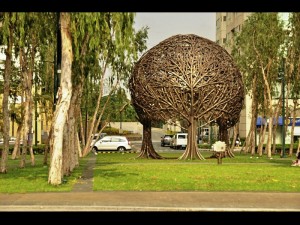
DOES your developer show efforts to integrate natural landscapes into the master plan? That’s just one of the many prerequisites to be truly green. Shown is the Burgos Circle at the Bonifacio Global City. TESSA R. SALAZAR
Fads happen not only in the world of fashion. If you’ve been a keen observer of property developments, you’ll notice that lately, developers are head over heels jumping onto the green bandwagon. Understandably, this should be raising some eyebrows. How capable are these developers to back up their claims? And are their claims of sustainable practices really “in tune” with the environment?
Last week at the International Green Building Conference 2011 in Singapore, Inquirer Property asked green building experts in attendance about this practice of “greenwashing” (which, like whitewashing, refers to any act of misleading consumers about the environmental merits of a company, its products and services, according to Green Architecture Movement founder Amado de Jesus).
“In the quest for balance between going green and increasing market share, it’s unavoidable that some will swing to the extreme. The only way that greenwashing can be prevented is by having a strong, objective green rating tool that’s acceptable by the government and the market. This is what Singapore has achieved,” said Tai Lee Siang, president of the Singapore Green Building Council.
10 qualities
The 10 qualities Siang believes a sustainable development should have are:
- Ø A healthy respect for the local climate;
- Ø Energy efficiency in its operations;
- Ø The willingness to use readily available materials;
- Ø Efficient manpower—less can do more;
- Ø The skill to use passive designs;
- Ø A greater dependence on natural light;
- Ø A greater reliance on natural ventilation;
- Ø A system that reinforces environment-friendly behavior among its staff and officers;
- Ø The methods to integrate natural landscapes;
- Ø The character of being user-friendly.
What to look for
Christopher Cruz de la Cruz, UAP, CBP, chair and president of the Philippine Green Building Council, said consumers and even the media should look for the following from any developer:
- Ø A “real” third party certification. “If the project is assessed and evaluated by the building owner, designer, contractor or any party that may have conflict of interest, it may be greenwashing.”
- Ø Conformity to internationally accepted standards. Such standards include ISO (International Organization for Standardization), WGBC (World Green Building Council), ASTM (American Society for Building Materials), Ashrae (American Society of Heating, Refrigerating and Air-conditioning Engineers) and GEN (Global Ecolabeling Network). There are also local standards and programs such as Philippine National Standard and Green Choice Philippines (for green materials).
- Ø Regulatory compliance checks. Is it built into the system?
- Ø The affiliation of the rating group. Is it part of the World Green Building Council? National GBCs are present in more than 80 countries and are leading the international markets in the development of green buildings.
- Ø Check Berde. In the Philippines, just look for the number of Berde stars to see the level of performance of buildings. Berde stands for Building for Ecologically Responsive Design Excellence, and is the first green-building rating system designed by Filipinos.
Greenwashing rampant
De La Cruz admitted that greenwashing has started to become rampant in the Philippines.
“Because of the additional perceived value of green, we now see more and more developers claiming green credentials. However, here at the PhilGBC we recognize that some of the greenwashing may be unintentional. That is why we work hard at delivering educational programs that enable building owners and consumers alike to ensure that they are empowered to carry out informed decisions when going green,” he said.
De la Cruz added that this has also been the reason for being of Berde. Berde ensures that a third party certification body with both local and international accreditation (ISO 17000 series) is present to do a qualified assessment on the level of sustainability of a project.
“Proper and unbiased rating of buildings is essential to enable the public to easily understand whether the property they are investing in is green or not. Berde is an objective set of tools that was designed using the UN Framework for Sustainable Development as a guide to ensure that the rating scheme is relevant to and for the Philippines, and comprehensive enough to cover our nation’s environmental priorities,” he said.
Dela Cruz explained that the National Green Building Councils are member-based to ensure that discussions are balanced, objective and unbiased.
“Here in the Philippines we now have all the major developers on board. We also have established partnerships with professional organizations and government.”
Currently, the Certified Berde Professional and Assessor (CBP and CBA) program has already signed up more than 150 certified professionals in the past four months. He added that the CBP and CBA programs are tangible contributions of the council in helping the Philippine government in transitioning the industry to a green economy. “This is also in support of our government’s green jobs creation agenda,” he quipped.

